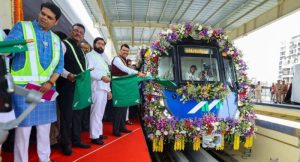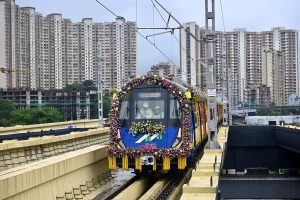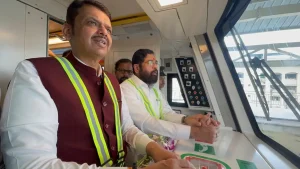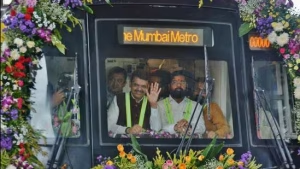Maharashtra – On September 22, 2025, the trial run of Mumbai Bullet Train or Metro Line 4 was inaugurated, marking a pivotal leap in the region’s connectivity and transport infrastructure. Chief Minister Devendra Fadnavis and Deputy Chief Minister Eknath Shinde flagged off the trials for Metro Line 4A (Gaimukh to Kasarvadavali) and Metro Line 4 (Kasarvadavali to Wadala via Teen Hath Naka and Ghatkopar), reflecting the government’s commitment to easing traffic and streamlining urban commutes. This new development comes alongside preparations for the ambitious corridor, highlighting the metro project’s importance for the city’s future transport plans.
Trial Runs: Metro Line 4 and 4A


The 2.88-km Metro Line 4A, with a projected cost of ₹949 crore, and the expansive 35.2-km Metro Line 4, set to cost ₹14,549 crore, are projects handled by the MMRDA. The first phase, a 4.4-kilometre stretch from Gaimukh to Vijay Garden, is set for completion by December 2025, serving four vital stations: Gaimukh, Govaniwada, Kasarvadavali, and Vijay Garden. Once operational, Metro Line 4 is expected to alleviate congestion on Ghodbunder Road—a persistent issue that has forced residents to protest, demanding better solutions—while also supporting bullet train integration along the corridor.
Thane Ring Route Metro

Meanwhile, work on the Thane ring route metro, a 29-kilometre circular line with 22 stations covering key localities, is scheduled to ramp up in October. Approved at a cost of ₹12,200 crore, this metro will offer a strategic arm connecting the line to the bullet train’s Thane HSR station in Dativali, as well as linking the metro to the trouble-prone Thane-Ghodbunder road and the suburban railway network. The bullet train connection is designed to enable swift travel between distant suburbs and business hubs, making bullet train transit an everyday reality for Thane’s residents.
Multi-modal Integration and Planning


Plans are underway for multi-modal integration and transit-oriented development at Thane and Virar HSR (bullet train) stations as part of project SMART. Surrounding these hubs will be built-up areas with office zones, transport corridors for buses and auto rickshaws, and dedicated metro rail links—each element reinforcing the role of the bullet train in shaping new patterns of urban movement. This comprehensive approach exemplifies the region’s shift towards integrating bullet train technology with traditional urban rail systems for maximum convenience.
Also Read: Lamborghini Coastal Road Accident – Shocking Crash on Wet Mumbai Stretch
Bullet Train Station and Timelines
On September 20, Union Railway Minister Ashwini Vaishnaw announced that the Mumbai-Ahmedabad bullet train corridor will touch Thane by 2028, and Bandra-Kurla Complex (BKC) by 2029. At BKC, the bullet train station is expected to intersect with Metro Line 2B at two locations, utilizing foot overbridges (FOBs) to facilitate passenger transfers. The bullet train’s extension to Thane positions the district as a crucial connection between Mumbai’s core and its expanding residential and business suburbs—a critical move for regional development.
Construction and Land Acquisition
Efforts have already begun to finalize contractors for constructing the Thane ring route metro, which will begin by January 2026. However, 3–4 km of land along the 29-km route still require acquisition from defense and forest departments, along with coastal regulation zone (CRZ) clearances. The metro’s integration with bullet train infrastructure remains a top priority in the urban planning framework, promising interconnected stations and seamless transfers for daily commuters.
Impact and Future Benefits

Once operational, the combined metro and bullet train network is expected to revolutionize urban travel by reducing commute times by 50–75%, and serving over 21 lakh commuters daily. The bullet train’s planned arrival and the new metro lines will together provide significant relief from traffic congestion, enhance business connectivity, and shape new real estate values across the city. Bullet train project planners predict that these transformative changes will be fully realized within four years after work commences, aligning perfectly with Mumbai’s growing need for efficient, modern public transport.
Conclusion
As the bullet train and metro projects move forward, Thane and Mumbai are set for a game-changing period in public transportation. The coordinated development of Metro Line 4, Metro Line 4A, the Thane ring route, and bullet train stations demonstrates a holistic approach to solving longstanding urban issues and opening up new economic possibilities. The bullet train is truly at the heart of these developments, propelling the city into a new era of connectivity, accessibility, and growth.

